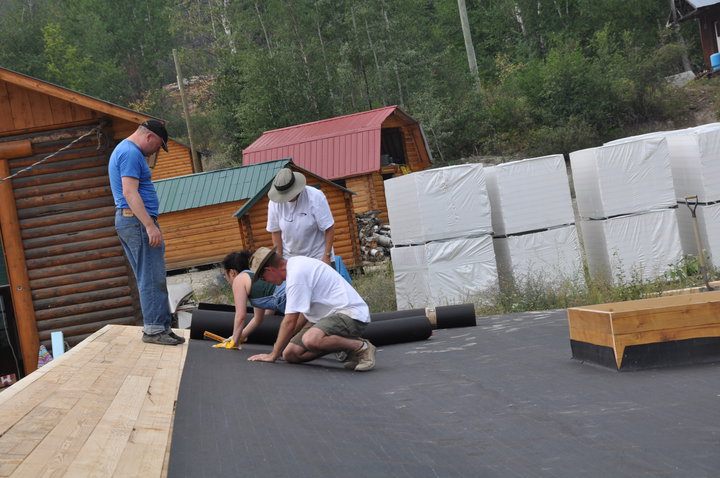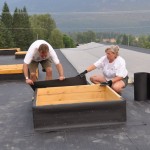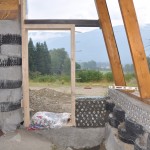
 Getting the roofing material on site lit a fire under us; yesterday we placed the 30# roofing felt on top of the 2×6 decking, and we started placing rigid insulation. Tom and Stephanie stopped by yesterday and they helped us place the felt …. thanks guys! After they left Sandra and I even managed to place the first two rows of rigid insulation on top of the felt (it was a long day). The kids had a good time writing messages on the roofing felt … hopefully I will not be the next one to see their messages!
Getting the roofing material on site lit a fire under us; yesterday we placed the 30# roofing felt on top of the 2×6 decking, and we started placing rigid insulation. Tom and Stephanie stopped by yesterday and they helped us place the felt …. thanks guys! After they left Sandra and I even managed to place the first two rows of rigid insulation on top of the felt (it was a long day). The kids had a good time writing messages on the roofing felt … hopefully I will not be the next one to see their messages!
 The rigid insulation is not entirely pleasant to work with; it is easy enough to cut and place it, but it has a fiberglass coat of some kind and you itch all over after handling it. We are placing two layers of 4″ thick rigid insulation for a total of 8″ and R50 (R25 per layer). The insulation going on top of the felt is a polyiso rigid insulation. As far as I can gather from the reams of information available on rigid insulation on the internet this rigid insulation has better R value per inch of material and it has to be kept dry to be effective. We mechanically attached the rigid insulation to our roof deck using screws made for the job (all of our roofing materials are Firestone products). The second layer of rigid insulation will be staggered so that the seams do not line up with the bottom layer to avoid thermal bridging and condensation. Condensation in the roof could ultimately lead to rot and mildew so we are being careful to make tight seams and we are taping all of the seams on the first layer.
The rigid insulation is not entirely pleasant to work with; it is easy enough to cut and place it, but it has a fiberglass coat of some kind and you itch all over after handling it. We are placing two layers of 4″ thick rigid insulation for a total of 8″ and R50 (R25 per layer). The insulation going on top of the felt is a polyiso rigid insulation. As far as I can gather from the reams of information available on rigid insulation on the internet this rigid insulation has better R value per inch of material and it has to be kept dry to be effective. We mechanically attached the rigid insulation to our roof deck using screws made for the job (all of our roofing materials are Firestone products). The second layer of rigid insulation will be staggered so that the seams do not line up with the bottom layer to avoid thermal bridging and condensation. Condensation in the roof could ultimately lead to rot and mildew so we are being careful to make tight seams and we are taping all of the seams on the first layer.
We tarped the roof yesterday evening when we were done for the day, and it is a good thing we did … it started raining last night and it has continued to rain on and off today. The good news is that the inside of the building stayed dry … we almost have a roof! The bad news was that we had to stop working on the roof since the insulation cannot get wet. Hopefully, we will be back at it by Monday.
 We spent today working on the pop can wall on the east side of the building. Over the last couple of weeks we have been preparing this wall; we framed the door opening, cut and nailed lathe to the edges of the wall to hold the cement wall in place and we flashed the bottom and the side of the wall. Today we actually started placing cement insulation and cans. We are using a double layer of rigid insulation in the middle of the wall and pretty much following the system described in Earthship Volume I. For now we plan to build the wall up to the lintel above the door. We will have a small roof over this door so we still need to do some framing above the door.
We spent today working on the pop can wall on the east side of the building. Over the last couple of weeks we have been preparing this wall; we framed the door opening, cut and nailed lathe to the edges of the wall to hold the cement wall in place and we flashed the bottom and the side of the wall. Today we actually started placing cement insulation and cans. We are using a double layer of rigid insulation in the middle of the wall and pretty much following the system described in Earthship Volume I. For now we plan to build the wall up to the lintel above the door. We will have a small roof over this door so we still need to do some framing above the door.
Other than that I have been working on the backhoe. We have had virtually no problems with this machine over the last year and it has been invaluable. Last week while helping move dirt for the back berm of the building I was unable to shift from forward to reverse. Surprisingly, the transmission would not disengage no matter how loudly I cursed or how hard I tried to push the immobile shift lever. I have never succeeded in fixing something by yelling at it, but I do not imagine I will give up trying. I had visions of a huge repair job, but when I finally convinced myself to open the transmission cover I discovered a simple problem; the set screw holding the shifting fork had fallen out and consequently the fork was not doing its job properly. These scres are wired in place so they do not fall out but the wire had finally failed. Fortunately, I had a spare screw that fit, was able to drill a hole through the top and was able to wire it in place. Unfortunately, I have not been able to find the old bolt. Hopefully, the old bolt is good and stuck in the housing and is not going to drift into the gears one of these days and chip something.
Wonderful Post. We really enjoy reading your updates and learning about your experiences. We just did a big tour here today, and three of the people are going to the earthship workshop with Mike Reynolds. One of the people (Patrick) owns the Thermomax solar hot water company here in Victoria…they specialize in the Mazdon solar Evacuated tubes out of Ireland. His son wants to build an Earthship and was looking for data on how these buildings perform in our climate…mostly with respect to moisture/humidity. I will send them your blog link.
Ann
Funny, we’ve had drive-by-ers for several days…by this I mean cars, trucks and vans pull into our yard, slow down slightly when they are right next to the east side of the house, stop, then speed up, do a loop and leave! At all hours of the day and night. Nobody has been getting out to find us or even stop when I wave them to stop. I can only assume these are folks headed up to Grant and Linda’s for the Biotecture build. I was a bit annoyed actually,. We don’t mind showing it off or talking about it even with people who don’t contact us ahead of time…but to arrive in our yard to gawk and point and then leave, even after I indicate I want to talk to them! I confess I put up the gate after this happened at 9:30 last night and I’m contemplating instituting a one-day-a-week showing of the house. I hate to do it, though, it’s not the way we wanted to share it. We’ve also had many kind, not-rude folks who’ve mentioned they were on their way to the build and asked if they could stop by (yes, yes, yes!). Also have had people who couldn’t get on the volunteer crew who want to volunteer with us. All very interesting. We are going back up to Linda and Grant’s at some point during the two weeks to see progress…look forward to meeting/hearing from Patrick!
Ann,
We visited an earthship on Vancouver Island that was built over a decade ago. I was quite impressed, and saw no evidence of moisture related issues. I think the most important issue is good site selection.